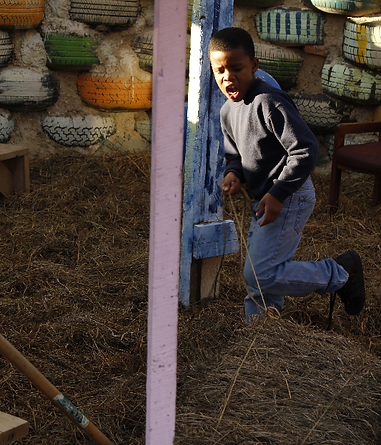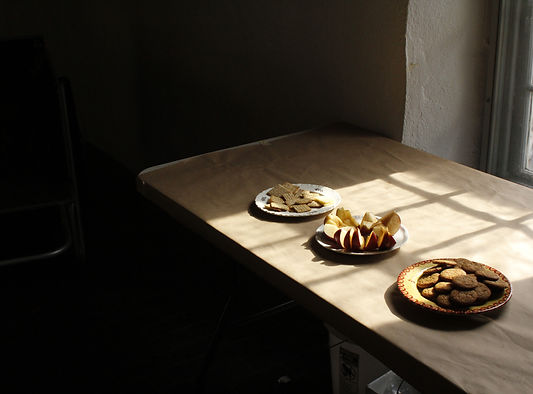
Peace park represents cohesive community in the heart of North Philadelphia, a culmination of fresh produce and community bonds. | Harrison Brink
In North Philadelphia stood an abandoned lot on the 2400 block of Bolton St near 24th and Oxford filled with rubble and refuse from the abandoned and demolished row homes that surrounded the area.
Three years ago, a resident of the area, Tommy Joshua, decided to take action after passing by the lot time and time again. “There was a lot of trash, and I like, ‘well, why isn’t anyone doing anything with the space? Look at all this land,’” says Joshua. With the help of some of his friends and neighbors, Joshua cleaned out the area and established the North Philly Peace Park. The community started growing flowers on the land and eventually began to plant fruits and vegetables.
The farm remains without a fence and easily accessible to the surrounding community, who are free to go at their leisure and pick fresh produce for themselves. “This is something beautiful that we’ve got going on here,” says Mr. Smith, a senior volunteer and neighbor of the park, “this is really the only place that you can really come and get your vegetables and it doesn’t cost you nothing.”
The park is a safe haven of sorts within an area considered by many to be dangerous. Joshua uses the park to try to positively influence the youth of the community, who are eager to come and spend time at the farm, helping out by just doing odd jobs around the area.

"There is something beautiful...going on here"
A local child helps drag a bay of hay into the schoolhouse on Friday, October 17, 2014. | Harrison Brink
Joshua and a few of his friends spent their day on Friday, October 17 covering a makeshift hut made out of tires and other repurposed refuse found in the area. The structure will be used from now on to conduct “Saturday school” for the kids in the area where they can attend workshops and be fed healthy, homegrown food.
The food is grown completely naturally, without any chemicals. “I want a tomato that’s real,” says Joshua, “I don’t want some kind of Frankenstein piece of fruit that’s going to give me cancer.” The produce that can be purchased at local grocery stores isn’t particularly fresh, inexpensive or close to many members of the community, which deters people from eating healthy. The park offers an alternative to this. “You go to the store and buy it, you’ve got all kinds of chemicals sprayed on it, you don’t really know what you’re getting,” says Smith, “out here, there is no chemicals, everything is grown right from the dirt.
The park is in danger, however, as the neighborhood received a Choice Neighborhoods grant for $40 million that officials want to use to develop the land where Peace Park is. “You can’t develop the neighborhood by destroying the popular development of the neighborhood,” says Joshua, “we believe that those who try to stop the Peace Park are going to be exposed as great criminals.”
Joshua doesn’t see the grant as a bad thing, per se, but there is a trust issue, and it largely centers around the park. The community consensus seems to be that the two can coexist, that the neighborhood can be developed and improved without touching the park. According to Joshua, “how ya’ll treat this park will show the sincerity of your intentions.” Joshua is confident that the park will stay standing and that the community will continue to show support for their endeavors.

A local child helps drag a bay of hay into the schoolhouse on Friday, October 17, 2014. | Harrison Brink
 North Philly Peace ParkNorth Philly Peace Park, on the 2400 block of Bolton Street. October 17, 2014. - Harrison Brink |  North Philly Peace ParkTommy Joshua levels the floor of the future schoolhouse, at North Philly Peace Park on October 17, 2014. - Harrison Brink |  North Philly Peace ParkThe new roof of the schoolhouse on the lot of North Philly Peace Park, October 17, 2014. - Harrison Brink |
|---|---|---|
 North Philly Peace ParkTomato plants grow on Peace park's once-abandoned lot. October 17, 2014. - Harrison Brink |  North Philly Peace ParkThe finished schoolhouse on Peace park's lot space, October 17, 2014. - Harrison Brink |  North Philly Peace ParkNorth Philly Peace Park, on the 2400 block of Bolton Street. October 17, 2014. - Harrison Brink |
 North Philly Peace ParkTommy Joshua putting up the new roof of the schoolhouse on the lot of North Philly Peace Park, October 17, 2014. - Harrison Brink |  North Philly Peace ParkTommy Joshua putting up the new roof of the schoolhouse on the lot of North Philly Peace Park, October 17, 2014. - Harrison Brink |  North Philly Peace ParkA stray dog walks amongst the spare rubble on Peace park's lot, that has not been completely cleaned out. October 17, 2014. - Harrison Brink |
 North Philly Peace ParkAn abandoned home in the same lot as Peace park. October 17, 2014. - Harrison Brink |  North Philly Peace ParkA butterfly rests amidst the foliage of North Philly Peace Park. October 17, 2014. - Harrison Brink |  North Philly Peace ParkWildflowers grow around the lot of North Philly Peace Park. October 17, 2014. - Harrison Brink |
 North Philly Peace ParkTommy Joshua and Asance Carter clearing garbage and dirt out of the Peace park lot. October 17, 2014. - Harrison Brink |  North Philly Peace ParkTommy Joshua solves a conflict between two fighting boys. "We will learn from this," October 17, 2014. - Harrison Brink |